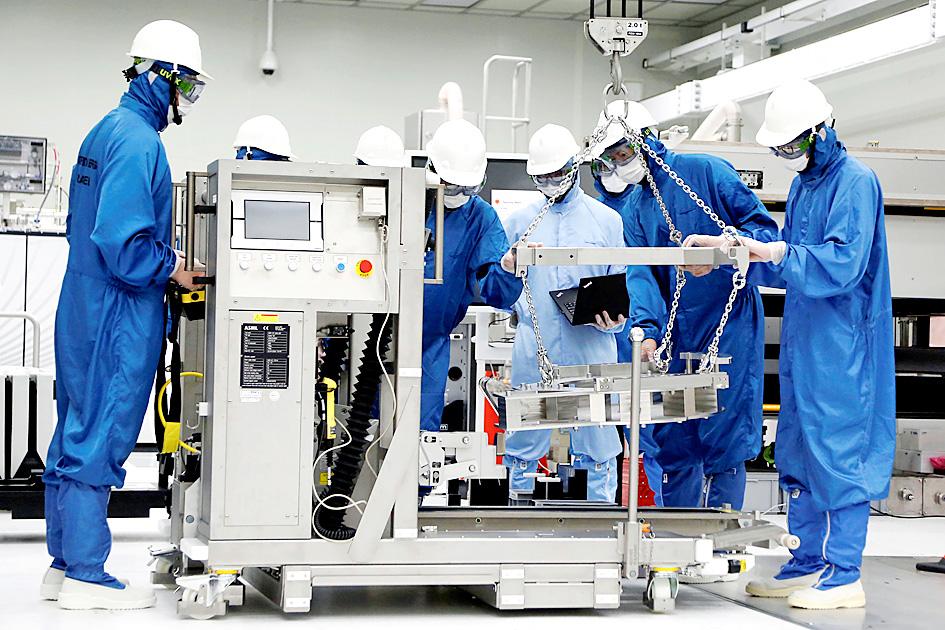The production value of Taiwan’s semiconductor industry was more than NT$65 billion (US$2.29 billion) last year, as the sector expanded capacity to meet rising global demand for 5G, Internet of Things and high-performance computing applications, the Ministry of Economic Affairs said on Friday.
Taiwan is home to the world’s largest pure-play wafer foundry operator, Taiwan Semiconductor Manufacturing Co (台積電), and the largest IC packaging and testing service provider, ASE Technology Holding Co (日月光投控).
Major foreign semiconductor companies, such as US-based DRAM maker Micron Technology Inc, also have production lines in Taiwan.

Photo: Ann Wang, Reuters
The ministry said that the industry generated NT$59.4 billion in production value in the first 11 months of last year, up 9.5 percent from a year earlier.
Output value for the whole of last year might be more than NT$65 billion, the ministry said, adding that this would be a record, after eight consecutive years of new highs.
In 2019, the industry’s output increased 5.8 percent to NT$60.3 billion from a year earlier, the ministry said.
China was the largest buyer of Taiwanese semiconductor equipment last year, accounting for 44 percent of exports, valued at US$1.5 billion, followed by Singapore (18 percent), the US (14.4 percent) and Malaysia (6.9 percent), Ministry of Finance data showed.
Taiwan last year imported US$23 billion of semiconductor equipment, down 1.1 percent from a year earlier, the data showed.
Japan was the largest supplier to Taiwan, accounting for 23.7 percent of equipment imports, followed by the US (22.2 percent) and the Netherlands (21.7 percent), it showed.

Taiwanese suppliers to Taiwan Semiconductor Manufacturing Co. (TSMC, 台積電) are expected to follow the contract chipmaker’s step to invest in the US, but their relocation may be seven to eight years away, Minister of Economic Affairs J.W. Kuo (郭智輝) said yesterday. When asked by opposition Chinese Nationalist Party (KMT) Legislator Niu Hsu-ting (牛煦庭) in the legislature about growing concerns that TSMC’s huge investments in the US will prompt its suppliers to follow suit, Kuo said based on the chipmaker’s current limited production volume, it is unlikely to lead its supply chain to go there for now. “Unless TSMC completes its planned six

Power supply and electronic components maker Delta Electronics Inc (台達電) yesterday said second-quarter revenue is expected to surpass the first quarter, which rose 30 percent year-on-year to NT$118.92 billion (US$3.71 billion). Revenue this quarter is likely to grow, as US clients have front-loaded orders ahead of US President Donald Trump’s planned tariffs on Taiwanese goods, Delta chairman Ping Cheng (鄭平) said at an earnings conference in Taipei, referring to the 90-day pause in tariff implementation Trump announced on April 9. While situations in the third and fourth quarters remain unclear, “We will not halt our long-term deployments and do not plan to

‘SHORT TERM’: The local currency would likely remain strong in the near term, driven by anticipated US trade pressure, capital inflows and expectations of a US Fed rate cut The US dollar is expected to fall below NT$30 in the near term, as traders anticipate increased pressure from Washington for Taiwan to allow the New Taiwan dollar to appreciate, Cathay United Bank (國泰世華銀行) chief economist Lin Chi-chao (林啟超) said. Following a sharp drop in the greenback against the NT dollar on Friday, Lin told the Central News Agency that the local currency is likely to remain strong in the short term, driven in part by market psychology surrounding anticipated US policy pressure. On Friday, the US dollar fell NT$0.953, or 3.07 percent, closing at NT$31.064 — its lowest level since Jan.

The New Taiwan dollar and Taiwanese stocks surged on signs that trade tensions between the world’s top two economies might start easing and as US tech earnings boosted the outlook of the nation’s semiconductor exports. The NT dollar strengthened as much as 3.8 percent versus the US dollar to 30.815, the biggest intraday gain since January 2011, closing at NT$31.064. The benchmark TAIEX jumped 2.73 percent to outperform the region’s equity gauges. Outlook for global trade improved after China said it is assessing possible trade talks with the US, providing a boost for the nation’s currency and shares. As the NT dollar